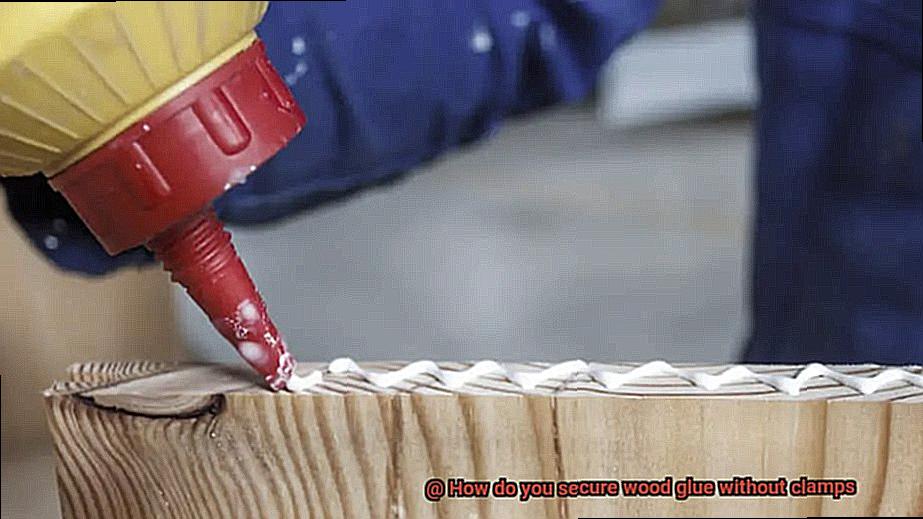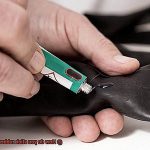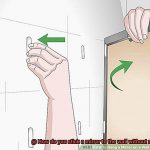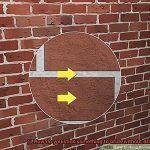Are you a woodworking enthusiast who’s looking to create beautiful pieces of art with your hands? Then, you know that using the right tools is essential for achieving the best results. However, sometimes you might not have access to one of the most important tools in your arsenal – a clamp.
Don’t worry. You can still secure your wood glue without clamps by using a few simple techniques. In this blog post, we’ll walk you through everything you need to know about securing wood glue without clamps.
First things first – preparation is key. Before applying any glue, make sure to clean and dry the surfaces you’re gluing together thoroughly. Also, ensure that you’re using the right type of glue for your project. This will help ensure that your glue holds strong even without clamps.
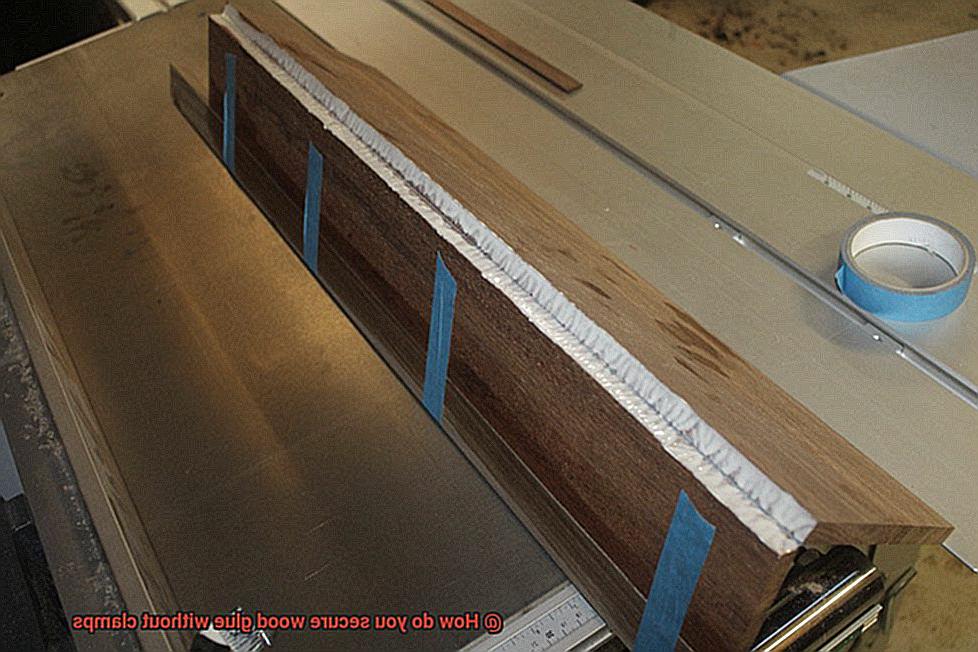
Now that your surfaces are prepped and ready to go, it’s time to get creative with how you hold them together while the glue dries. One option is to use masking tape to hold pieces together tightly. Another technique involves using weights or heavy objects placed on top of the glued area.
By following these tips and tricks, you can achieve professional-quality results on your woodworking projects without needing clamps. So whether you’re looking for a quick fix or just want to experiment with new techniques, keep reading to learn more about securing wood glue without clamps.
What Are the Alternatives to Clamps for Securing Wood Glue?
Contents
- 1 What Are the Alternatives to Clamps for Securing Wood Glue?
- 2 Using Heavy Objects to Secure Wood Glue
- 3 Advantages and Disadvantages of Using Heavy Objects
- 4 Using Masking Tape or Painter’s Tape to Secure Wood Glue
- 5 Advantages and Disadvantages of Using Tape to Secure Wood Glue
- 6 Using a Vise or Clamp-Like Device to Secure Wood Glue
- 7 Advantages and Disadvantages of Using a Vise or Clamp-Like Device
- 8 Conclusion
There may be situations where clamps are not practical or available. Fortunately, there are several alternatives to clamps that can be used to secure wood glue effectively.
One alternative to clamps is using weight. By placing heavy objects such as books or bricks on top of the glued area, you can create enough pressure to hold the pieces together until the glue sets. This method is especially useful for smaller projects.
Another option is using tape. Tape can be applied along the edges of the glued area to hold the pieces together. However, it’s important to ensure that the tape is tight enough to hold the pieces together but not too tight that it squeezes out all of the glue. You should also avoid leaving the tape on for too long as it may leave sticky residue on the wood surface.
For larger projects, screws or nails can also be used to hold the pieces of wood together. However, be careful not to screw them in too tightly as this may cause the wood to split.
Furthermore, specialized clamping tools are available in various shapes and sizes that can be used as an alternative to traditional clamps. These tools can be used for different types of joints and angles, making them a versatile option.
Using Heavy Objects to Secure Wood Glue
This tried-and-true method requires nothing more than some books, bricks, or even sandbags. It’s a technique that can save your project from going awry due to insufficient pressure on the glued surface. To use this method, start by applying the glue to the wood surface and positioning the two pieces together. Then, place a heavy object on top of the glued surface and let it sit for the recommended drying time. The weight of the object will ensure that the two surfaces are held tightly together while the glue dries.
However, using heavy objects to secure wood glue requires some consideration. One factor to keep in mind is evenly distributing the weight across the surface. Uneven weight distribution can cause warping or bending of the wood, which can affect your final product’s quality. Choose an object that covers the entire surface area of the glued pieces to avoid such issues.

Another crucial factor to consider is the weight of the object itself. Too much weight can cause excess pressure and squeeze out too much glue from between the surfaces. On the other hand, too little weight may not provide enough pressure to hold the surfaces together. When choosing an appropriate weight for the job, consider factors like the type of wood you’re using and how much glue you’ve applied.
Advantages and Disadvantages of Using Heavy Objects
This simple yet effective method involves using weights like books or bricks to apply pressure to the glued surfaces, ensuring a strong bond. Before you dive into this technique, let’s examine the advantages and disadvantages of using heavy objects for this purpose.
Firstly, one of the biggest advantages of using heavy objects is accessibility. You don’t need any special tools or equipment – just find some heavy objects lying around your house or workshop. This makes it a convenient solution that can be used in a pinch. Additionally, using heavy objects is cost-effective. Unlike purchasing specialized clamps, using heavy objects is a budget-friendly option that won’t break the bank.
Secondly, heavy objects are incredibly versatile. They can be used in a wide variety of woodworking projects regardless of the size or shape of the materials being glued together. This makes it an adaptable solution that can be used in many different situations.
However, there are also some downsides to consider when using heavy objects. One of the biggest drawbacks is limited pressure. Compared to clamps, the pressure applied by heavy objects may not be as consistent or strong, which can lead to weaker bonds that are more prone to breaking over time.
Additionally, uneven distribution is another potential issue when using heavy objects. Depending on the shape and size of the objects being glued together, it may be difficult to distribute the weight evenly across the entire surface area. This can result in gaps or weak spots in the bond.
Finally, there is a risk of damage when using heavy objects. Placing a weight on a delicate or fragile material can cause warping or cracking if not done carefully. It’s important to choose an appropriate amount of weight and distribute it evenly to avoid any potential damage or weak bonds.
Using Masking Tape or Painter’s Tape to Secure Wood Glue
When it comes to securing wood glue, clamps are often the go-to method. However, what if you don’t have access to clamps or are working on a small project? Fear not, as masking tape or painter’s tape can come to your rescue. This popular and effective method can hold wood pieces together while the glue dries, creating a strong bond.
Here are the steps you need to follow:
- Step 1: Apply a generous amount of wood glue to one of the surfaces that you want to bond together.
- Step 2: Align the two pieces of wood and press them firmly together.
- Step 3: Wrap the masking tape or painter’s tape tightly around the wood pieces, making sure to apply pressure so that the pieces are held tightly together.
But before you start taping away, there are a few things you need to keep in mind. First, not all types of tape are suitable for this method. It’s essential to use a high-quality masking tape or painter’s tape that can withstand the pressure and tension of holding the wood pieces together. Don’t skimp on the tape.
Secondly, it’s crucial to remove the tape after the glue has dried but before it becomes fully cured. This will prevent the tape from becoming stuck to the wood and causing damage when you remove it.
Using masking tape or painter’s tape to secure wood glue without clamps is an easy and effective solution for small projects or situations where clamps aren’t available. Need more convincing? Here are some additional benefits of this method:
- It’s inexpensive
- It’s easy to apply and remove
- It doesn’t require any special tools or equipment
Of course, this method may not be suitable for larger projects, but it’s perfect for those small DIY projects around the house. With proper techniques and materials, this method can create a strong bond between wood pieces that lasts for years to come.
Advantages and Disadvantages of Using Tape to Secure Wood Glue
Fear not, tape can be a lifesaver for securing wood glue. But before you grab any old roll of tape, it’s important to weigh the advantages and disadvantages of using tape in this way.
Let’s start with the benefits. Firstly, accessibility. Tape is a common household item that can be found almost anywhere and can provide a quick solution for securing wood glue without the need for clamps. Secondly, versatility. Tape can be used on a variety of surfaces, making it a flexible option for securing wood glue. And finally, ease of application. Applying tape is a simple process that does not require any special tools or equipment.
However, there are also some drawbacks to consider. Firstly, limited strength. Tape may not provide enough pressure to hold the wood pieces together tightly, which can result in weak joints. Secondly, residue. Some types of tape may leave behind sticky residue on the wood surface that can be difficult to remove. And lastly, uneven pressure. If the tape is not applied evenly, it can cause uneven pressure on the joint, resulting in an unstable connection.
In summary, while tape can be a helpful tool for securing wood glue without clamps, it may not always be the most reliable option. It’s important to consider the specific needs of the project and weigh the pros and cons before deciding to use tape as a substitute for clamps.
To ensure success when using tape to secure wood glue, there are a few tips to keep in mind. Use high-quality tape that is strong and won’t easily tear or break during use. Additionally, make sure to apply even pressure across the joint to create a strong bond between the wood pieces. Finally, remove the tape before the glue fully cures to prevent any damage or residue left on the wood surface.
Using a Vise or Clamp-Like Device to Secure Wood Glue
Woodworking is a beautiful craft, but it requires precision and patience. One of the most crucial aspects of woodworking is securing wood glue during a project. While traditional clamps are a popular choice, using a vise or clamp-like device can be just as effective and an excellent alternative option. In this post, we’ll explore how to use a vise or clamp-like device to secure wood glue in your next project.
First things first – what exactly is a vise or clamp-like device? A vise is a mechanical device that holds and clamps materials in place, while clamp-like devices are similar but smaller and less powerful. Both tools are designed to apply pressure and hold pieces of wood together while the glue dries.
To get started, apply the wood glue to the surfaces that need to be joined. Then, position the pieces of wood together in the desired position. Now it’s time to bring out the big guns – your vise or clamp-like device.
Open the jaws of your chosen tool and place them over the wood. Tighten the jaws until they are snug against the wood, but be careful not to over-tighten them as this can cause damage to the wood. It’s also important to ensure that both pieces of wood are aligned correctly before applying pressure with your tool.
Using a vise or clamp-like device requires attention to detail and patience. Take your time when positioning your pieces of wood and tightening your tool’s jaws. This will ensure that your project stays securely in place while the glue dries, resulting in a high-quality finished product that will last for years to come.
In summary, using a vise or clamp-like device is an excellent alternative to traditional clamps for securing wood glue in your woodworking projects. By following these simple steps, you can ensure that your project stays secure and results in a beautiful finished product. So go ahead and give it a try – your woodworking projects will never be the same.
Additionally, it’s worth noting that there are different types of vises and clamp-like devices available, including bench vises, C-clamps, and bar clamps. Choose the one that best suits your project’s needs and don’t be afraid to experiment with different tools to find what works best for you.
Advantages and Disadvantages of Using a Vise or Clamp-Like Device
As a woodworker, you know that securing wood glue is essential for building sturdy and long-lasting projects. But when it comes to choosing between a vise or clamp-like device, it can be tough to decide which one will work best for your needs. So, let’s break down the advantages and disadvantages of these tools.
Let’s start with the positives. One of the primary benefits of using a vise or clamp-like device is that they provide even pressure across the entire joint surface area. This even distribution ensures that the glue is evenly applied, resulting in a strong bond without any gaps or spaces. Additionally, once you have secured the wood pieces in the vise or clamp, you can move on to other tasks while the glue dries – allowing for hands-free operation.
However, there are some downsides to consider. Firstly, clamps and vises can be expensive, especially if you require multiple ones for larger projects. Additionally, these tools can leave marks or indentations on the wood surface, which may be difficult or impossible to repair, especially if working with delicate or intricately designed pieces. Finally, some woodworkers may prefer a more hands-on approach to securing wood glue.
To sum it up, while there are both advantages and disadvantages to using a vise or clamp-like device when securing wood glue, these tools remain popular among woodworkers due to their convenience and reliability.
LLQa_koALNA” >
Conclusion
In conclusion, don’t let the absence of clamps stop you from achieving a secure wood glue bond. With a little creativity and some helpful tips, you can achieve professional-quality results without traditional clamping methods.
Firstly, preparation is key. Make sure to clean and sand the surfaces before applying glue to ensure maximum adhesion. Once your pieces are ready, consider using weights or heavy objects to hold them together tightly while the glue dries. Alternatively, masking tape can be used to create temporary clamping pressure.
If you’re looking for a more specialized solution, there are a variety of alternative clamping tools available that can provide even pressure across the entire joint surface area. From vices to clamp-like devices, these tools offer an effective way to achieve a strong bond without gaps or spaces.
However, it’s important to weigh the pros and cons of each technique before deciding which one is right for your project. Some methods may be more cost-effective or accessible than others but could potentially cause damage to delicate materials.
By following these tips and experimenting with different techniques, you’ll be able to achieve high-quality results on your woodworking projects without relying on traditional clamps.

